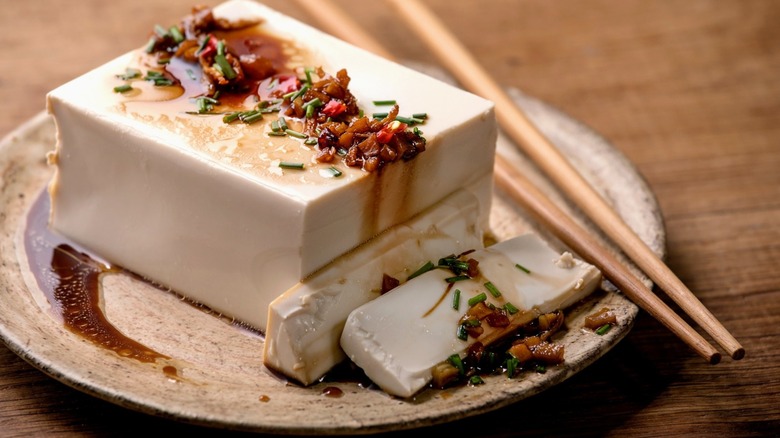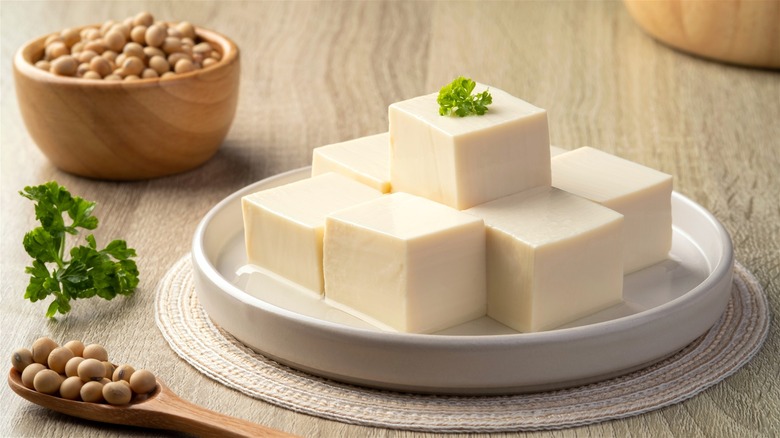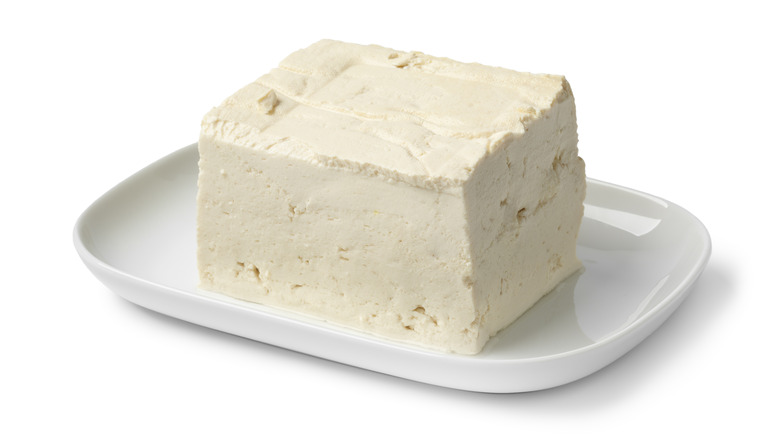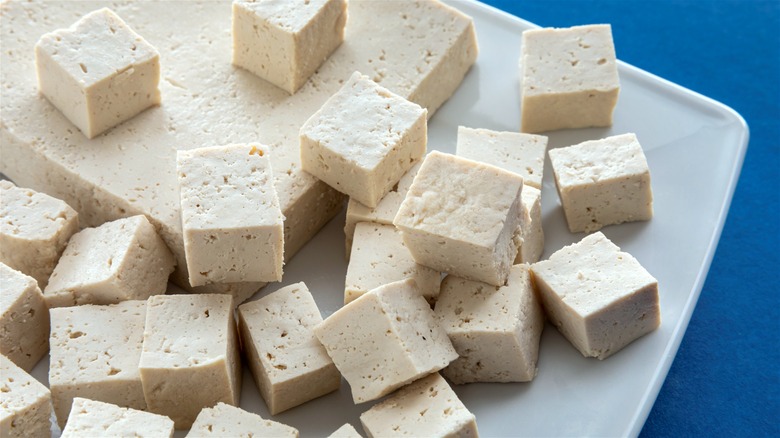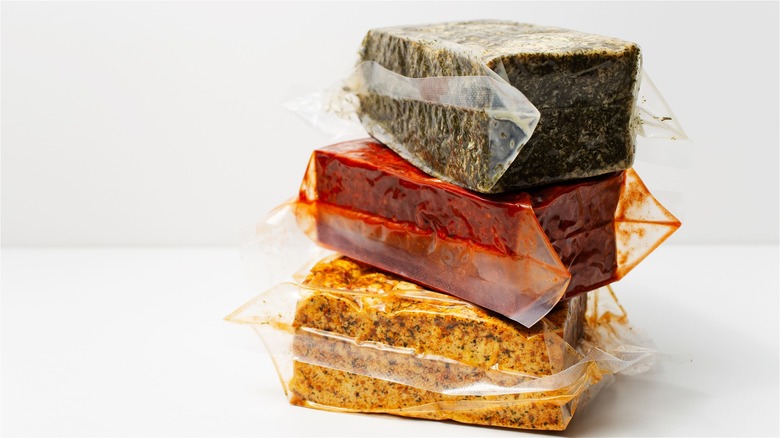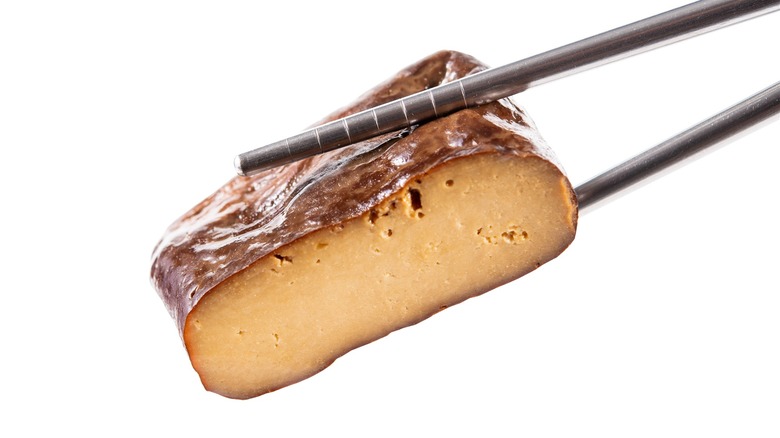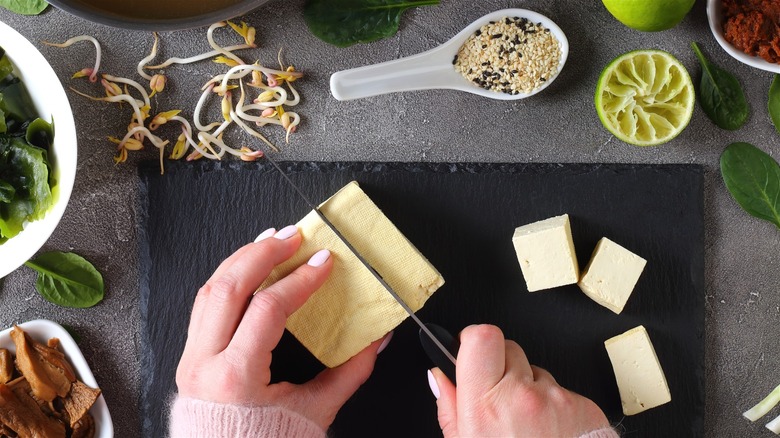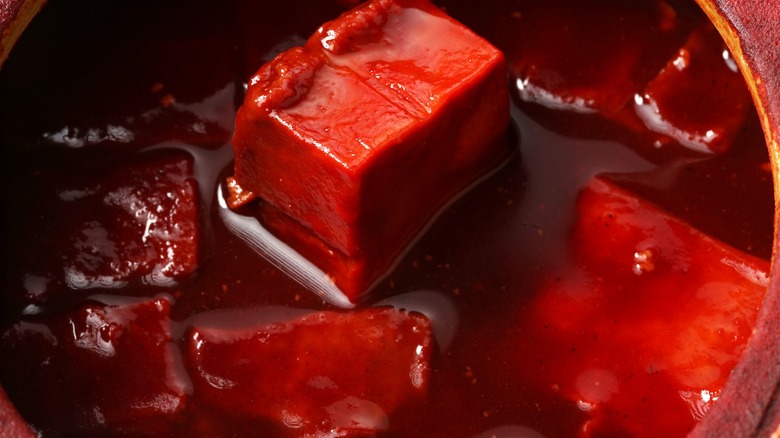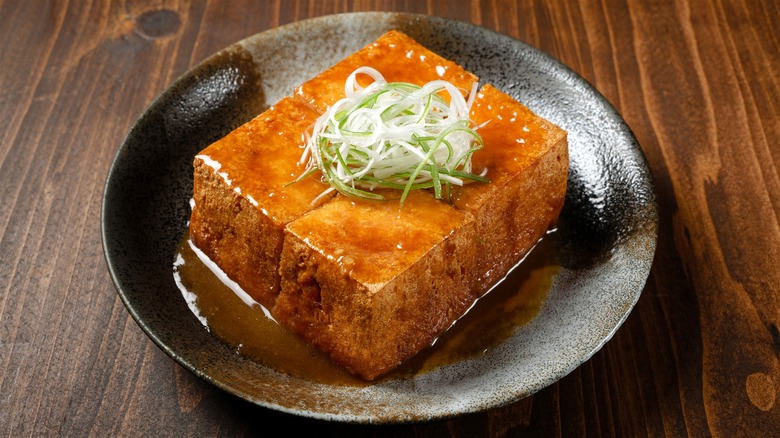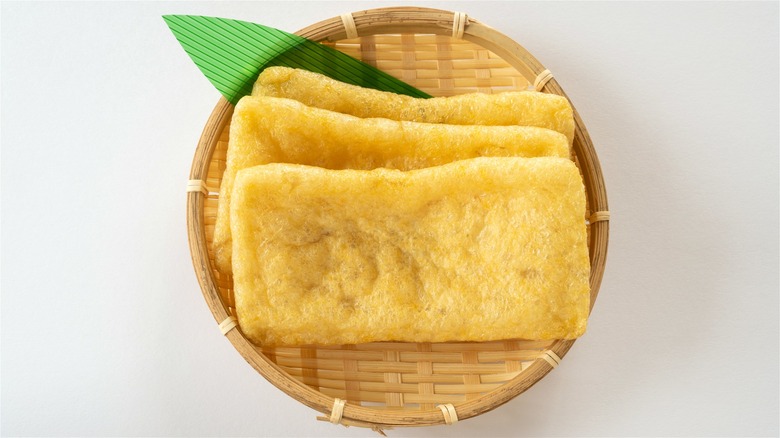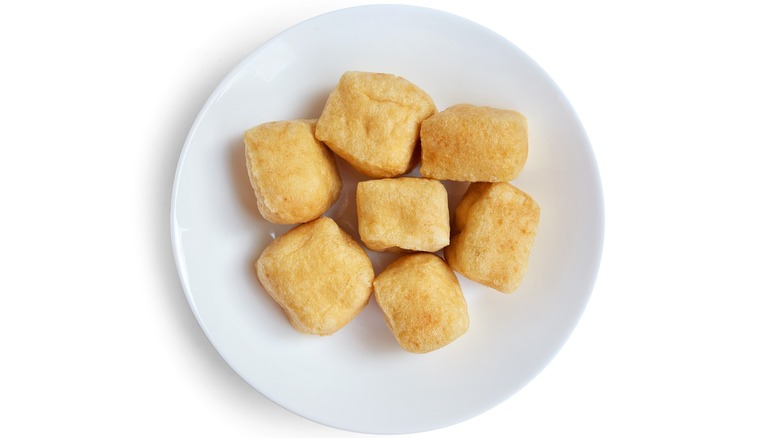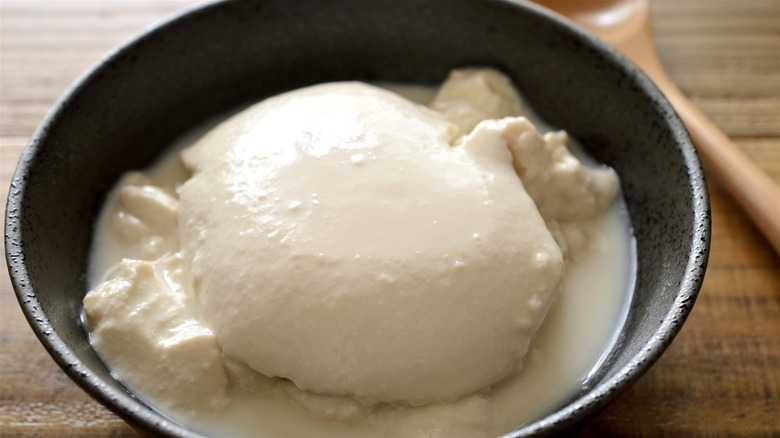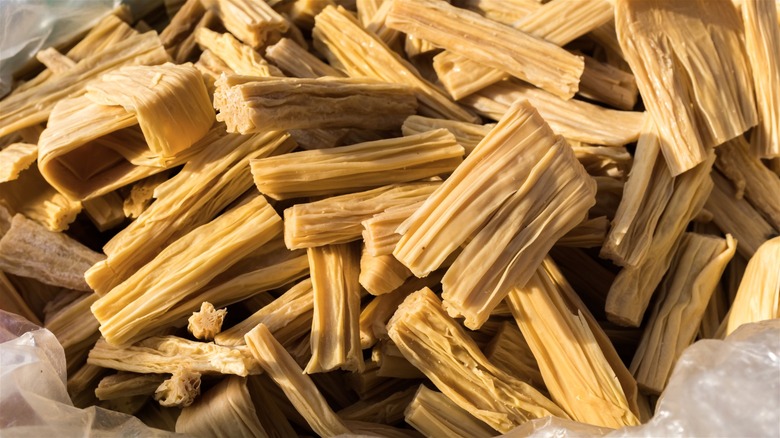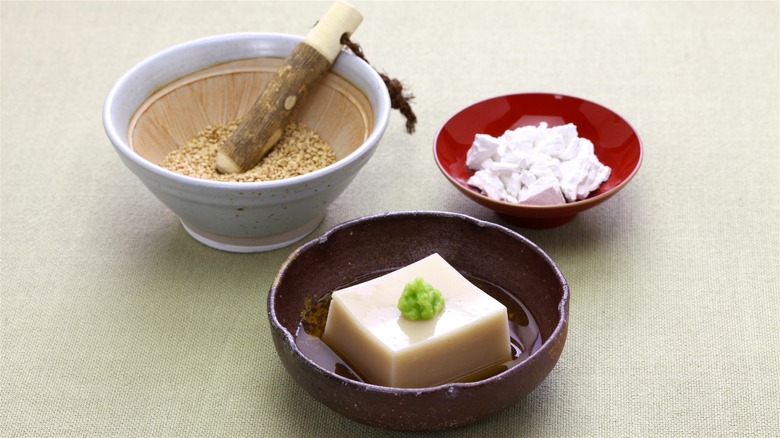15 Types Of Tofu And How To Use Them
Let's be honest: If you still think that tofu is bland and boring, it's time to step up your culinary game. After all, it's the 2020s, and plant proteins are all the rage. By now, humanity has found so many different ways to add more flavor to tofu. But maybe the flavor (or lack thereof) isn't the problem — sometimes you're unintentionally setting yourself up for failure by choosing the wrong block for the job. Frankly, it's one of the biggest tofu mistakes you can make. That's why it is necessary to explore different varieties to see how you can properly match their qualities with their intended use.
Ready to dive deeper? If you're itching to find out the difference between yuba and dòufu pí, whip up inari sushi from scratch, figure out which tofu could pass for cheese in a police lineup, and never suffer through a dry tofu scramble again, you're in the right place. Whether you're a new vegan or a curious plant-forward eater, let's explore the wide world of tofu together, leaving no block unturned.
Silken tofu
Most tofu varieties begin with soy milk. In the case of Japanese-style, aka silken tofu, the milk is poured into a container, where it is coagulated with calcium sulfate or glucono delta-lactone and left to rest and firm up. Unlike the Chinese-style tofu blocks, silken tofu is never pressed during production or cooking. As a result, it is very wet and low in protein — and its texture is very fragile. It is typically sold in two forms: shelf-stable and waterless, encased in Tetra Pak, or fresh, in an aseptic plastic container or tube, similar to Korean sundubu or extra-soft tofu.
Silken tofu, known for its delicate, homogenous, and jelly-like texture, requires a gentle touch. While silken tofu does come in soft, firm, and extra-firm varieties, it is no match for other types of tofu as a meat substitute. Rather, it shines as a stand-alone dish, like Japanese hiyayakko, where the tofu is garnished with soy sauce and vegetables. Other ways to use silken tofu include blending it into plant-based sauces, smoothies, ice creams, and mousses and using it as an egg replacer in quiche and pancakes.
Soft tofu
You'll find soft tofu a little farther down the firmness scale. At first, it might seem like silken tofu's twin, but on closer inspection, they're more like cousins. Although they might have similar uses, the production process and texture are not the same. Silken tofu is completely poreless and custard-like, while soft tofu is slightly grittier and firmer.
Soft tofu is considered the Chinese equivalent of Japanese silken tofu. Like other varieties, it's made from soy milk that's been curdled and pressed to remove the whey. As the name suggests, though, it is pressed very briefly, thus retaining a lot of moisture.
If the recipe calls for blending the tofu into a drink, sauce, or dessert, you can swap silken for soft tofu. Lightly pressed, soft tofu holds up a bit better as an egg replacer in tofu scrambles and hot and sour soups than its silken counterpart. While shallow-frying might not be the best idea due to its high water content, soft tofu works well for deep-fried dishes, such as agedashi and homemade tofu puffs.
Medium tofu
Medium tofu is another type of block tofu. The pressed soy milk curds have a firmer texture than silken tofu but are still relatively squishy and tender, similar to soft, fresh cheese. The Japanese call this and other firmer varieties "momen tofu" or "cotton tofu" to distinguish it from silken.
Medium tofu should be your go-to choice if you prefer your vegan scramble on the drier side. Alternatively, you can slice it and fry it with some turmeric and black salt to create an "egg" patty for a breakfast sandwich. Because medium-firm tofu is slightly firmer than softer varieties, it can also stand up to poaching, which gives the tofu an incredible texture. The secret to this technique is thoroughly salting the boiling water to extract moisture from tofu instead of waterlogging it. This creates firmer, springier cubes or slices, which you can then eat as is or toss with cornstarch and shallow-fry before using it to top a ramen or salad bowl. Medium tofu is also excellent when frozen and thawed for vegan fried "chicken" recipes.
Firm tofu
Firm tofu, the versatile workhorse of the plain block tofu family, is the type of tofu you'll encounter in most savory recipes. It's the driest, meatiest, and grainiest of the lot, as most of the water is pressed out of it before it gets to your kitchen. When shopping for this variety, you'll find various labels such as firm, medium, extra, and super firm. Bear in mind that the vacuum-packed blocks will be firmer than the ones sold in water-filled tubs, and the firmness often also depends on the brand.
If you're a tofu novice, this is the variety for you. It's sturdy enough to hold up in an air fryer without drying out. Yet, it is pliable enough to be creamed into a thick sauce or whipped into a plant-based ricotta alternative. Many firm tofu preparations call for pressing, cubing, marinating, and pan-frying or baking the tofu, like in this maple sesame tofu recipe. However, if you freeze it whole, then thaw it and gently press out the moisture, it will take on a new, spongy texture that's perfect for soaking up marinade flavors and being deep-fried for a rendition of Japanese katsu or popcorn chicken.
Smoked tofu
All tofu is technically pre-cooked and ready to eat, but smoked tofu is even more poised for your next recipe. Unlike its bland, watery kin, this dense, meaty, and flavorful tofu is ready to go at all times. It gets its signature flavor and dark skin from being smoked over tea leaves or beech wood chips, although sometimes liquid smoke is used. It holds up so well on its own that it might just become the gateway drug into the world of tofu for those who still scoff at the concept of this source of vegan protein.
So, if you've been holding yourself back because you're skeptical about tofu's capacity to go from bland to bold or are daunted by the task of pressing, marinating, and cooking other varieties, we recommend you start your tofu journey with this smoked variety. After all, incorporating smoked tofu into your diet requires virtually zero prep or cooking skills. You can eat it straight out of the package, layer it on sandwiches, cube it into a salad bowl, crush it into a vegan mince for bolognese and lasagna, or whip it into a protein-packed pâté with mushrooms and nuts.
Pressed tofu
Those familiar with Chinese cooking might know this type of tofu under the name dòufu gān, which translates to "dried tofu." As the name implies, pressed tofu is on the denser side. However, it retains some of its moisture and is closer in texture to smoked tofu rather than freeze-dried tofu. You'll likely find it in Chinese grocery stores where it's sold in small, vacuum-packed blocks. It typically comes in plain and seasoned flavors. The former is off-white, smooth, and grateable like mozzarella, while the latter is amber or brown in color and is seasoned either with soy sauce or a five-spice mix. Both have a chewy, rubbery texture that works well when contrasted with softer ingredients, like noodles, dumpling dough, or stir-fried green beans.
If pressed tofu is unavailable where you live, you can make it yourself. Slice one block of firm tofu into several slimmer pieces and press them between weighted plates in the fridge for a few hours. Then, you can braise them, marinate them overnight, and bake them until they're flavorful and dry.
Sprouted tofu
Sprouted tofu, like other types of tofu, begins with cooked soybeans. However, unlike regular tofu, the soybeans for this sprouted product are not raw and dry. Instead, they are germinated, which reduces the effects of anti-nutrients, compounds that would otherwise inhibit the uptake of certain nutrients and minerals. This means that sprouted tofu could be easier for you to digest, and the delivery of its nutritional value to your body will be streamlined.
You probably won't notice the difference in terms of texture and flavor between sprouted tofu and your go-to firm block, but the nutritional benefits speak for themselves. While any soy-based tofu is a source of complete protein — a rare find for those who don't eat animal products — sprouted tofu boasts an even higher protein content. Additionally, it has three times as much calcium, which is excellent for people eating primarily plant-based diets.
The best part is that you don't have to switch up your tofu-cooking routine to use sprouted tofu — just use it wherever you would use regular firm tofu and get more nutrients from already beloved dishes.
Freeze-dried tofu
If you're an experienced tofu user, you may have already tried to freeze tofu to create a spongy, fibrous texture. Some advocate that this is the best — and only — way to cook tofu because it allows the flavors to not only graze its surface but disperse throughout the block. Freeze-dried tofu, aka koya dofu, takes this idea to the next level. It originated in Japanese Buddhist monasteries, where it was left outside in the cold and then dried when the sun shone on it. When the water evaporated, it could be used as a portable and lasting source of sustenance for traveling monks. Today, it remains a part of shojin ryori but is also an everyday staple in Japanese households.
The industrially made koya dofu is sold as brittle, hard, vacuum-packed slabs. Freezing and thawing it multiple times during production removes almost all the moisture, leaving behind a dry, bread-like texture. So to cook with it, you'll need to reconstitute it in broth or water first. Its absorption abilities are unparalleled, so it thrives in liquid-heavy dishes like soups, stews, curries, and hotpots. Its dense, fibrous texture makes it a passable meat substitute, too. Alternatively, you can grind the dry tofu and use it as a substitute for breadcrumbs.
Fermented tofu
While tofu is sometimes mistakenly called "soy cheese," only the fermented variety comes close in terms of production, flavor, and texture. Unlike its pale, bland cousins, fermented tofu usually packs a flavor punch. Inoculating the block with various molds takes its texture and taste to soft-ripened cheese territory. It typically has a creamy, spreadable consistency and a funky, intense flavor and is best used in moderation as a condiment rather than a protein source.
Ready to expand your tofu horizons? Look no further than the jars of Chinese furu (which roughly translates to "tofu cream"), most commonly sold in the U.S. Otherwise known as fermented bean curd, this type of tofu comes in white and red varieties. The red is more intensely flavored and salty and is made with red yeast rice. Try it in a vegan char siu sauce or as a congee topping.
There are many different regional preparations of fermented tofu. Okinawans replace the salt brine with awamori, a rice-based alcoholic drink, creating a milder-tasting tofu. The Vietnamese spin on fermented tofu is called chao; its subtle umami flavor makes a perfect base for a vegan cheese dip.
Thick deep-fried tofu
There are several types of deep-fried tofu, but atsuage, as it is known in Japan, is best enjoyed fresh, so it's unlikely you'll find it at a supermarket. Fortunately, you don't have to travel to Japan (or even your closest Japanese restaurant) to try atsuage; it's easy to recreate at home. All you'll need is to press a block of tofu, cut it into 1-inch slabs, pat them dry, and deep-fry them whole. The contrast between the crispy skin and delicate, soft inside is a key feature of atsuage, so refrain from using firm tofu and pick a variety with a bit more moisture, like soft or medium.
When atsuage is ready, you can top it with soy sauce, ginger, and scallions and enjoy it immediately. If you plan to cook with it, you'll need to de-oil it first by soaking it in boiling-hot water for a few minutes. Otherwise, it won't soak up the seasonings. Pat it dry, then simmer it in a mix of dashi, mirin, soy sauce, ginger, and sugar for a sweet-and-savory spin, or use it as a meat substitute in stir-fries and barbecue.
Thin twice-fried tofu
Unlike the solid blocks of atsuage, aburaage resembles a thin, porous pouch. Its signature texture is achieved by deep-frying thin slices of pressed firm tofu in moderately hot oil and then repeating the process in even hotter oil. The first frying stage causes the tofu to puff up, while the second fry gives it its golden color and creates an air pocket inside. Its flavor is quite neutral and rather oily, so you'll need to soak it in boiling water to get rid of the greasy flavor before you add it to dishes like soups and stews.
Store-bought or homemade aburaage, makes for great inari sushi. To transform it into inari age, the basis for the sushi, you'll first need to braise it in a mixture of dashi, mirin, soy sauce, and sugar to soak up all the flavors. Then stuff the tender tofu skins with sushi rice, and enjoy!
Tofu puffs
If the thin pouches of aburaage are not your jam, try experimenting with tofu puffs, aka dou fu pao. Unlike aburaage, the tofu puffs are only deep-fried once, making their texture less airy. Nevertheless, they are spongy enough to soak up braising liquids, marinades, and broths. They're juicy flavor bombs in curries and stews. Even a simple vegetable stir-fry will benefit from the pleasant mouthfeel they bring to the table. The puffs are traditionally used as a meat substitute, so you might consider flavoring them as you would animal proteins. For example, marinating and baking them on skewers is a great way to add flavor and make this tofu a centerpiece of your meal.
You can order tofu puffs online or search for them in the refrigerated section of Chinese groceries. They're typically sold in cubes, triangles, or squares. As a bonus, deep-fried tofu is already so devoid of moisture that freezing it won't alter its texture too much.
Oboro tofu
Oboro tofu, a delightful midpoint between silken and soft varieties, is born out of the stage of tofu production when warm soy milk is mixed with a coagulant. In Japan, this coagulant is often nigari, a liquid seawater extract packed with magnesium chloride and other minerals. The resulting curdles are gently scooped out and served immediately. There are two popular varieties of oboro tofu: yose and zaru tofu. Yose tofu is served in a bowl, while zaru tofu is drained to give it a slightly firmer texture.
You can easily make oboro tofu at home by briefly microwaving pure soy milk with nigari. Unlike other kinds of tofu, the curds are not soaked, pressed, or allowed to solidify fully. The soybean flavor really shines through in this fresh tofu, and it has a unique creamy, wobbly, and melt-in-your-mouth texture. It is, therefore, best enjoyed as is, with minimal seasoning — maybe with just a touch of salt or soy sauce.
Tofu skin
In Japanese cuisine, tofu skin is known as yuba. In Chinese cuisine, the skin is called fǔzhú and can be found as dry, fibrous sticks that need to be rehydrated before cooking. You may also see tofu skin sold in Asian grocery stores as yellowish or translucent sheets. Although tofu skin (or beancurd skin) is a widely-known name, it is a bit of a misnomer since the skin is not shaved off the block itself.
Instead, this tofu product is made from the thick film of coagulated proteins formed on the surface of soy milk after it boils. It is carefully scooped off and eaten fresh or dried into sheets or sticks. Tofu skin shouldn't be confused with dòufu pí — another tofu skin variety made directly from tofu pressed into thin sheets.
Fresh soymilk-based tofu skin is best enjoyed as is or with minimal seasoning. The dried strips or sheets must be soaked for up to an hour before they can be added to soups, stews, and saucy entrees. The sheets can also be used as dumpling wrappers.
Flavored tofu
Some kinds of tofu don't technically qualify as tofu because they are not soy-based. However, they can offer a soy-free alternative that's equally as tasty.
Japanese goma dofu, for example, is a mainstay of the country's temple cuisine. It's made from crushed sesame seeds thickened with kudzu starch (which you can replace with potato starch in a pinch). Goma dofu has a tender, jelly-like consistency and is best enjoyed with just a dash of wasabi or miso sauce. Okinawan jimami tofu is made with soaked and blended peanuts cooked with sweet potato starch.
Unlike other varieties that use legume or seed milk as a base, Burmese (or Shan) tofu is made from chickpea flour mixed with water, turmeric, and oil that has been cooked down to a thick paste. The paste cools in a mold to form "tofu" sturdy enough to be sliced or cubed and pan-fried. You can also make tofu from other legumes that have been soaked, blended, and cooked without straining.

